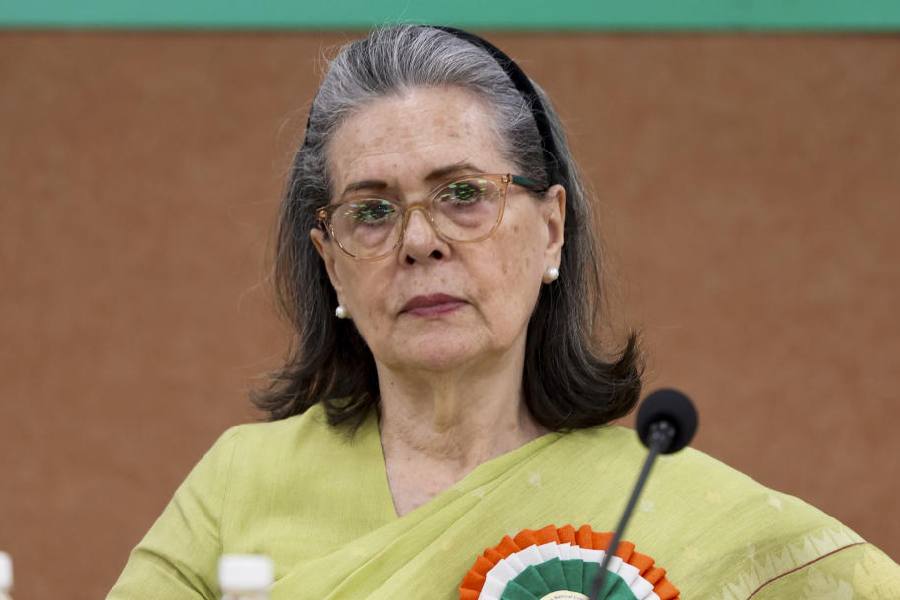 |
| Interiors of Cubes, a multicuisine restaurant on AJC Bose Road. Picture by Rashbehari Das |
Multicuisine. Indian, Chinese, Conti. I must confess that this kind of description of a restaurant makes me feel increasingly uncomfortable. It involves a huge menu, and the question of whether the quality and authenticity can be maintained right across the board must be a valid one. Also, it is not a universal phenomenon; it seems to be more popular in this part of the world than anywhere else. Even the small eatery down my street where the average cost of an item is between 10 and 30 rupees, now bears this legend on the signboard: ?Delicious Indian and Chinese dishes.?
Actually, some of my most favourite old restaurants in Calcutta serve up at least two, if not three, kinds of cuisine. But one has never gone there with the idea of trying more than one. For me, Mocambo means Continental food. Bar-B-Q means Chinese. Amber and Park Street?s Kwality (both do have Continental items on the menu though it would not be accurate to describe them as multicuisine), mean north Indian.
There must be reasons for running such a place. For business and profit, it might be a good idea to have something to offer, for everyone. It might result in a higher footfall. A family of six, from dadu to natni, goes out for a meal. Dadu wants Chinese, dida wants chingri malai, bouma wants pasta, natni wants pizza, nati wants fish and chips and chhele wants biryani.
Another reason must be: ?Bagchi is stodgy, old-fashioned. I want to start with Cream of Asparagus Soup and Mutton Boti Kebab or Drums of Heaven. Then I?ll have Tandoori Roti and Kali Dal followed by Chicken Hakka Chow and Veg Manchurian, and dessert.? Of course. It?s a free country.
The other day I visited a place called Cubes Kitchen and Lounge at 209, AJC Bose Road (it is actually in a little lane that hugs the southern wall of Karnani Estate), which is just such a place. Indian. Chinese. Continental. Chatting with the executive chef, Snehasis Sinha, I told him that while I loved to try new things, I was conservative in that mixing cuisine styles at a single meal was not my cup of tea.
Acting on his advice, and on a perusal of the menu, showed that the Indian selection was the most varied while the Chinese and Continental ones were fairly standard and common, it was decided to have an all-Indian (north Indian) lunch. Chef also pointed out that the Indian menu had a few signature items which I was unlikely to find anywhere else.
For example, Irani Fish Kebab, a great starter and quite a nawabi dish. Prime bekti is cut into large, diamond-shaped chunks and marinated for half an hour in green chilli paste, ginger-garlic paste and lemon juice. Meanwhile, a second marinade is prepared combining hung yoghurt, cashewnut paste, aniseed powder, cardamom powder, salt and crushed roasted peanuts. A little egg white is used to help these ingredients cling to the fish, which is put in this second marinade for at least six hours, after being drained from the first.
The kebabs are then cooked in a moderately hot tandoor, and are served with a chilled green chutney of mint and coriander which is more full-bodied in consistency than in most places because here the fresh mint, coriander, ginger-garlic paste and green chillies are pureed together with cashewnuts and cream. The chutney is seasoned with salt, sugar and lemon juice, and is finger-licking good, even on its own.
Like a good Bengali, I was going to move from course to course methodically, so the main course began with the Vegetarian Amritsari Chana with Amritsari Kulcha, also signature dishes at cubes. The chana is prepared by first heating butter and oil in a wok and tempering this with cumin seeds, ajwain and whole red chillies. Onions are added, followed by chopped tomatoes, turmeric powder and red chilli powder. Cashew, cream and tamarind also go into this gravy. When it is cooked to a smooth consistency, the chickpeas, which have already been boiled in water with salt, turmeric, ginger and green chillies, are added. The dish is finished by seasoning with ajwain powder, cumin powder and dry mango powder.
The Amritsari Kulcha is quite a speciality. Contrary to my expectations, it did not appear in the shape of a much enlarged Bengali luchi, but was a layered bread, resembling a puff-pastry, with a rich stuffing of grated cottage cheese, mashed potato, chopped cashewnuts and raisins, chopped coriander, seasoned with salt, sugar and lemon juice. The dough is made with refined flour, ghee, milk, dry pomegranate, cumin seeds, ajwain, saffron, kasturi methi and salt.
The non vegetarian main course item was Murgh Tikka Lababdar, which is chicken tikka kebabs cooked in a lababdar gravy, which is equal quantities of onions and tomatoes cooked in butter and seasoned with white pepper and cardamom powder. I mentioned that the lababdar gravies at Kalash, Hotel Hindusthan International, used to be great and chef Sinha said that his Murgh Lababdar was in fact inspired by Chef Aftab?s of HHI. The lababdar was accompanied by tandoori roti.
The only time I am comfortable mixing cuisines is for dessert, and the meal duly ended with Chocolate Monte Carlo, an indulgence involving chocolate sponge cake, hazelnut prolines, chocolate and vanilla ice-cream, chocolate chips and syrup.
Other items to watch for are their Yellow Methi Dal, and Paneer Pahari Masala ?paneer in a smooth, full-bodied coriander, green chilli, cashew paste, onion paste and cream gravy.
Even with many Indian restaurants vying for people?s favour, a gut feeling says that the Indian menu at Cubes will make a mark on our tastebuds. And if you are going Continental, the chef recommends the Mixed Grill Sizzler or the Italian Sizzler.











![Rishabh Pant, Sachin Tendulkar [in set]](https://assets.telegraphindia.com/telegraph/2025/Jun/1750511937_new-project-33.jpg)